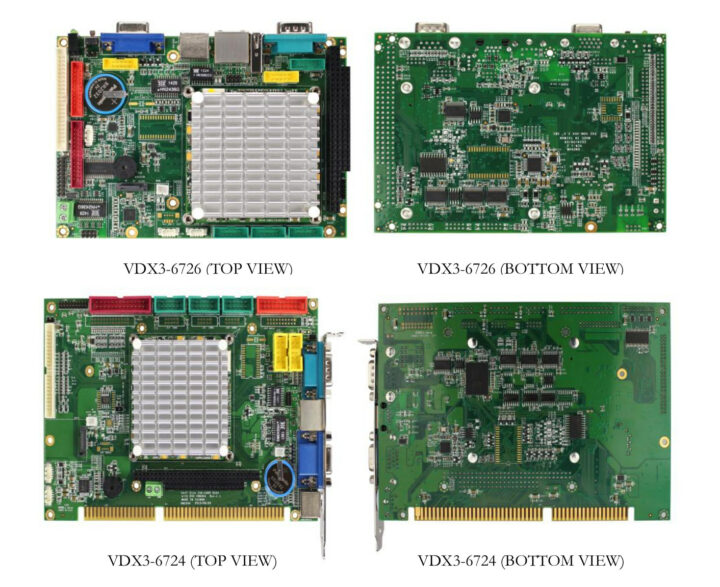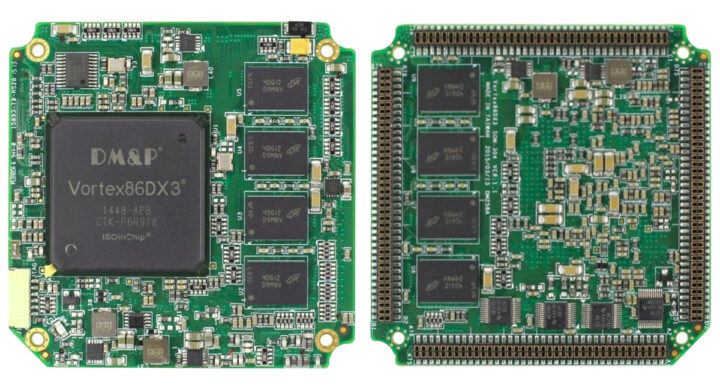DM&P Vortex86DX3 is an x86 embedded processor launched in 2015 that we’ve previously found in single board computers and mini PCs, but I’ve just noticed ICOP was offering the SOM304D3 system-on-module based on the single and dual-core versions of the Vortex86DX3 SoC.
The SOM304D3 is available with 1 or 2GB DDR3 RAM, works in a wide temperature range (up to -40°C to +85°C), and is designed for space-constrained industrial applications, especially those requiring legacy interfaces like ISA, IDE, and/or a parallel port (aka printer port).
SOM304D3 specifications:
- SoC – DM&P Vortex86DX3 single or dual-core x86 processor @ 1 GHz, 2D GPU
- System Memory – 1GB or 2GB DDR3
- Storage – Optional 4GB eMMC flash; SPI flash for AMI BIOS
- 4x 76-pin board-to-board connectors:
- Storage – SATA 1.0, IDE, SD
- Display
- VGA up to 1920 x 1080 @ 60Hz
- TFT LCD up to 1024 x 768 @ 60Hz
- Audio – 1x HD audio
- Networking – 2x 10/100M Ethernet
- USB – 4x USB 2.0
- Up to 80 GPIO or up to 9 UART, SPI, I2C, PWM, LTP (Parallel Port), up to 3 PWM
- Up to 8x ADC
- Expansion – 2x PCIe 1.1, 1x 16-bit ISA
- Misc – PS/2 keyboard and mouse interfaces, plus “4S/4U”, but I have no idea what this is…
- Power Supply – +5V DC @ 1,300mA (Typical)
- Dimensions – 70 x 70 x 10.5 mm (without cover)
- Weight – 25 grams
- Temperature Range – -20°C to +70°C or -40°C to +85°C (option)
As an x86 platform, the module supports plenty of – usually older – operating systems: FreeDOS, DOS 6.22, PCDOS 7.1, DR-DOS, x-DOS, OS/2, Windows 7, Windows Embedded Standard/Compact 7, Windows Embedded CE 6.0, Windows XP Professional/Embedded, POS Ready (WePOS), embedded Linux, QNX, VxWorks, FreeBSD.
 ICOP also offers at least two carrier boards for evaluation: the VDX3-6726 SBC and the VDC3-6724 board with an ISA interface.
ICOP also offers at least two carrier boards for evaluation: the VDX3-6726 SBC and the VDC3-6724 board with an ISA interface.
I found out about the board in a January 2022 press release, but the module is a bit older than that since the product page provides documents and drivers dated from 2018. The SOM304D3 system-on-module sells for $260 with 1GB RAM on ICOP online store, while the a complete kit with VDX3-6726 and cables goes for $372.

Jean-Luc started CNX Software in 2010 as a part-time endeavor, before quitting his job as a software engineering manager, and starting to write daily news, and reviews full time later in 2011.
Support CNX Software! Donate via cryptocurrencies, become a Patron on Patreon, or purchase goods on Amazon or Aliexpress





